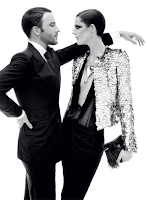Some of you may know, I attended Lindsay Adler's Creative Live Fashion Flair workshop. It was AWESOME! I had such a great time. People have asked me what it was like. In the words of Oprah, I can say there were many 'AHA' moments. Let me explain.
During Lindsay's session with the male model in continuous light (the tic tac toe tubes), she was explaining how to get the nice shallow depth of field where the subject's eyes are in focus, but everything else falls soft. She was saying to have the subject lean forward. I understood the words that she was saying, but for some reason, I couldn't picture what it meant to have a subject lean forward. Until she had the model do it. AHA! It was so simple. Lean forward as in bend at the waist so that the head and shoulders are closer to the camera.
For some reason, before taking her workshop, I thought the way to get that shallow depth of field meant standing on a chair or ladder and having the subject look up at you. It didn't click what Lindsay meant until she actually had him do it. I could hear it, but couldn't see it in my mind. You know how in cartoons, a light bulb will turn bright above somebody's head? Well, that was me during that session. Sometimes seeing someone do something on a video or in person is extremely helpful. And Lindsay's tip was definitely that. But that wasn't the only AHA! that I had.
While we were in the alley shooting the 1950s theme with the car and couple, I got a chance to shoot. For the past few months, I've been trying to improve my composition techniques, so I've been shooting a lot of leading lines. So I figured with that beautiful classic car, I'd work on the leading lines. I also like hands, and I knew that I wanted the young 'bride' to gently touch her new 'hubby's' face. I wanted to lead you to that moment between the couple.
As I shot the scene, Lindsay gave me feedback on how to improve the shot. As we looked at the back of the camera, the leading line was not having the impact that it should. I got half a headlight or a whole headlight in the first few shots. Then Lindsay told me that I needed to shoot 'into the line', not start at the headlights. That way the line could lead you to the couple. AHA! What a difference that made! It looked so much better when the lines from the hood and side of the car led to the couple.
There were so many AHA! moments watching Lindsay. I was struck by how quickly she processed ways to improve our shots when we did our student shoots. Many times I was wondering how she could instantly 'see' that a chair, hip, or leg looked too prominent in a scene. I would have gotten back to Virginia and downloaded the images before realizing that something looked too big in an image. (Too late. I'm back in VA and the 'bride's' hip in the image below looks a little prominent.) So the AHA! moment for that was 'pay attention to the setup and what your eye keeps going to in a shot'.
So those are some of the great learning moments from her workshop. As you all saw, Lindsay is a great teacher who knows her stuff. After watching her workshop, I hope many of you are saying AHA! too...
















